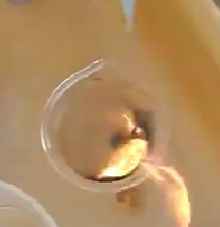PICTURES COMING SOON
Spontaneous ignition: the powerful oxidant (potassium permanganate and sulfuric acid) reacts with ordinary ethanol to create a flame without a match. A more dangerous demo, done in a safe area at a safe distance, is nitric acid as the oxidant in a shallow dish. Have an adult do the whole demo.
Equipment and supplies: potassium permanganate ($$, where), concentrated sulfuric acid (get a small quantity, say, 100 ml; $XX), ethanol (get a small quantity of denatured alcohol, perhaps at a hardware store; $10), big beaker (400 ml is good, from a chemical supply house or Carolina Biological Supply; $5), 2 smaller beakers for the acid and the alcohol (50 ml each, $6), eyedropper
Precautions: foremost, only have an adult who knows chemistry to the demo. Have on hand baking soda (better: commercial acid neutralizing powder) to neutralize spilled acid; wear gloves, goggles, and a lab coat; prepare to wash exposed flesh with water copiously, as at a wash stand; run the demo on an acid-resistant counter. Concentrated sulfuric acid is an extremely corrosive liquid. It attacks flesh, even charring it if it is in contact form more than a few seconds. It also reacts vigorously with water. A dollop of water put into the acid creates so much heat that the water vaporizes into steam and splashes the acid around. Never add water to sulfuric acid; add acid to water, if you must.
On to the fun
We’re going to mix beautiful purple potassium permanganate with sulfuric acid to make a very strong oxidizer. When we drip ordinary alcohol onto it, the alcohol bursts into flame every time. We’ll look at why this happens.

Here’s the chemistry of it all: Potassium permanganate has the formula KMnO4. It has the most oxygens that can fit around a central atom and it can readily release those oxygens for a chemical reaction. Other compounds with so much oxygen are similarly powerful oxidants – perchloric acid (HClO4), osmium tetroxide (OsO4), potassium dichromate (K2Cr2O7) are among these.
Oxidation is defined accurately and inclusively as the extraction of electrons from a fuel. In ordinary combustion the chemical species that pulls off the electrons is oxygen. Since we’re considering the combustion of common alcohol (ethanol, C2H5OH) as the fuel, let’s look at the overall reaction of alcohol burning in air. The oxidant is then atmospheric oxygen, O2. All the carbons become carbon dioxide, CO2, and all the hydrogens become water. For complete combustion the summary is
To start this reaction at room temperature, we need a source of ignition. It can be the hot flame from a match. It can be a strong electrical spark. There has to be something that starts tearing apart some of the ethanol molecules into pieces that readily undergo further chemical reactions. The whole process of burning to CO2 and water is quite complex.
There’s more to it. The reaction only keeps going if the heat that’s liberated by burning some of the fuel is effective in heating the next “batch” of fuel. Liquid fuels such as ethanol spread out the heat well, so that it’s hard to keep the flame going unless the alcohol itself is warmed. You can’t make a flambé dinner entrée with cold cognac or rum as the source of alcohol.
This reaction is different. We have to add the very strong acid, sulfuric acid, H2SO4, which turns the potassium permanganate into the potent oxidant MnO4–, a free proton H+, and potassium sulfate. The permanganate ion, MnO4–, readily provides all its oxygens for oxidizing the alcohol, becoming reduced itself to the state called manganous; the manganous ion is formally written as Mn2+. We can look at it as if manganese started with 7 positive charges and ended up with 2 positive charges by taking up electrons from the fuel.
Running the reaction: We start with potassium permanganate on the bottom of the large beaker. A convenient amount is 5 grams; you can weigh it out on a small laboratory scale or you can just use ½ teaspoon. If the crystals are coarse, you should grind them to a powder, which is easy using a mortar and pestle (again from a chemical supply house, or even a kitchenware store). Make it aggregate into a pile rather than spread out over the bottom of the beaker, such as by tilting the beaker. Add a similar volume of the concentrated sulfuric acid. Take great care to avoid spills. It’s convenient to pour from the bottle of acid into a small beaker and then from the small beaker into the big beaker with the permanganate crystals. Don’t use too much acid or the reactive “paste” will be too diluted with acid, which is not the primary reactant.
Pour a few milliliters of ethanol into a small beaker. Draw a few ml into the eyedropper. Hold the eyedropper over the acid/permanganate paste and release a single drop. It will burst into flame. The permanganate ion reacts so rapidly with ethanol that the heat builds up very quickly, making the ethanol and acid mixture very hot. It’s akin to lighting a match. Aiding the rapid heat build-up is the sheer density of the oxidizer; the alcohol is exposed to all that oxygen in a small volume.
Connection to rocket flight: The reaction is termed hypergolic, or hyper-energetic, from the German hypergol. The erg in that word refers to work (Greek ergon), also construed as energy. Some rocket engines used hypergolic propellants that burst into flame on contact in the combustion chamber. That made engine starting more reliable. Modern high-performance rockets such as NASA’s Delta rockets, the Russian Proton rockets,, or the Space-X Falcon use “safer” fuels such as liquid oxygen and kerosene; ignition is done with technical expertise.
A note on color and physics: The permanganate ion is one of the most intensely colored substances known. It colors water a deep and beautiful purple, even at very high dilutions. Permanganate is an exceptionally strong absorber of light – almost all across the colors in the spectrum, leaving only a bit of the red and blue, making purple. Try adding a few grains to a beaker of water. Note that handling the solid with your fingers will leave you with a strong purple stain, which slowly changes to a rather permanent brown stain as the permanganate oxidizes your skin oils and becomes the insoluble manganous oxide. Wash off any permanganate stains quickly. The same staining will occur on other surfaces, such as your clothing; take care.
